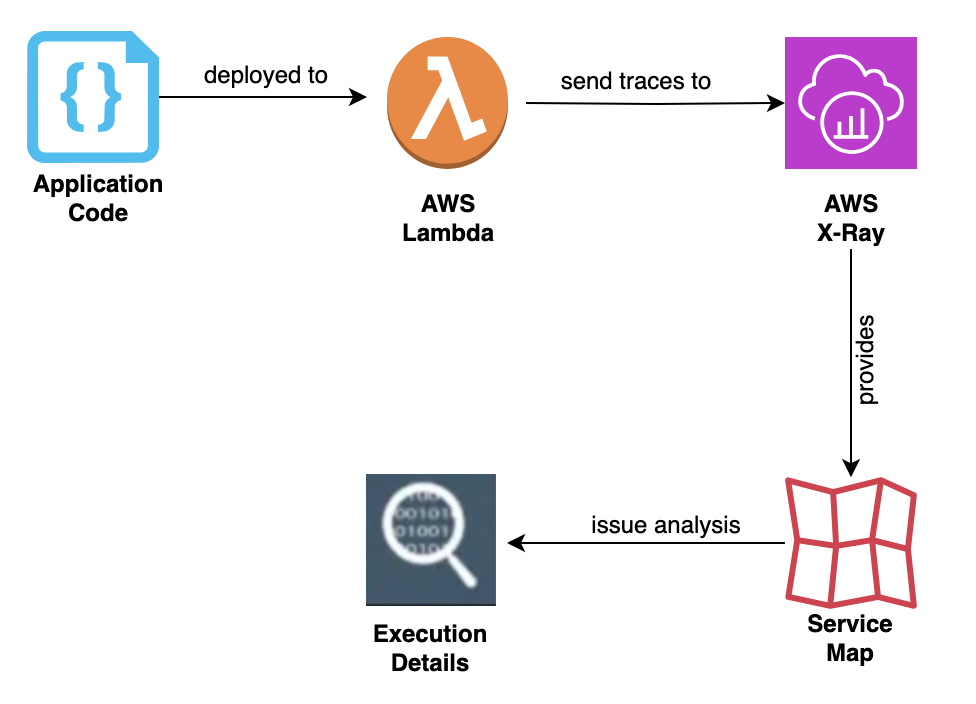Lambda Tracing with AWS X-Ray
In the world of serverless computing, observability is crucial for ensuring the reliability, performance, and efficiency of your applications. AWS Lambda, the cornerstone of serverless architectures, provides a powerful and scalable platform for running event-driven code without the need to manage underlying infrastructure. However, as applications become more distributed and complex, traditional logging and monitoring techniques often fall short in providing a comprehensive view of the end-to-end request flow and performance.
AWS X-Ray addresses this challenge by offering a powerful distributed tracing service that enhances observability for serverless applications built with AWS Lambda. By integrating AWS X-Ray with your Lambda functions, you can unlock a range of benefits and capabilities that enable you to gain deeper insights into your application's behavior and performance:
-
End-to-End Visibility: AWS X-Ray traces requests as they flow through your Lambda functions and other AWS services, providing an end-to-end view of the complete lifecycle of a request. This visibility helps you understand the interactions between different components and identify potential bottlenecks or issues more effectively.
-
Performance Analysis: X-Ray collects detailed performance metrics, such as execution times, cold start latencies, and error rates, for your Lambda functions. These metrics allow you to analyze the performance of your serverless applications, identify performance hotspots, and optimize resource utilization.
-
Distributed Tracing: In serverless architectures, requests often traverse multiple Lambda functions and other AWS services. AWS X-Ray provides a unified view of these distributed traces, enabling you to understand the interactions between different components and correlate performance data across your entire application.
-
Service Map Visualization: X-Ray generates dynamic service maps that provide a visual representation of your application's components and their interactions. These service maps help you understand the complexity of your serverless architecture and identify potential areas for optimization or refactoring.
-
Integration with AWS Services: AWS X-Ray seamlessly integrates with a wide range of AWS services, including AWS Lambda, API Gateway, Amazon DynamoDB, and Amazon SQS. This integration allows you to trace requests across multiple services and correlate performance data with logs and metrics from other AWS services.
-
Custom Instrumentation: While AWS X-Ray provides out-of-the-box instrumentation for AWS Lambda functions, you can also instrument your custom code within Lambda functions using the AWS X-Ray SDKs. This capability enables you to trace and analyze the performance of your custom logic, providing a more comprehensive view of your application's behavior.
 Figure 1: Sending traces from Lambda to X-Ray
Figure 1: Sending traces from Lambda to X-Ray
To leverage AWS X-Ray for enhanced observability of your Lambda functions, you'll need to follow these general steps:
-
Enable X-Ray Tracing: Configure your AWS Lambda functions to enable active tracing by updating the function configuration or using the AWS Lambda console or AWS Serverless Application Model (SAM).
-
Instrument Custom Code (Optional): If you have custom code within your Lambda functions, you can use the AWS X-Ray SDKs to instrument your code and emit additional trace data to X-Ray.
-
Analyze Trace Data: Use the AWS X-Ray console or APIs to analyze trace data, view service maps, and investigate performance issues or bottlenecks within your Lambda functions and serverless applications.
-
Set Up Alerts and Notifications: Configure CloudWatch alarms and notifications based on X-Ray metrics to receive alerts for performance degradation or anomalies in your Lambda functions.
-
Integrate with Other Observability Tools: Combine AWS X-Ray with other observability tools, such as AWS CloudWatch Logs, Amazon CloudWatch Metrics, and AWS Lambda Insights, to gain a comprehensive view of your Lambda functions' performance, logs, and metrics.
While AWS X-Ray provides powerful tracing capabilities for Lambda functions, it's important to consider potential challenges such as trace data volume and cost management. As your serverless applications scale and generate more trace data, you may need to implement sampling strategies or adjust trace data retention policies to manage costs effectively.
Additionally, ensuring proper access control and data security for your trace data is crucial. AWS X-Ray provides encryption for trace data at rest and in transit, as well as granular access control mechanisms to protect the confidentiality and integrity of your trace data.
In conclusion, integrating AWS X-Ray with your AWS Lambda functions is a powerful approach to enhancing observability for serverless applications. By tracing requests end-to-end and providing detailed performance metrics, AWS X-Ray empowers you to identify and troubleshoot issues more effectively, optimize resource utilization, and gain deeper insights into the behavior and performance of your serverless applications. With the integration of AWS X-Ray and other AWS observability services, you can build and maintain highly observable, reliable, and performant serverless applications in the cloud.